Northern Nevada Heritage Railroads: Riding the Trains That Served the Mining Industry
categories: USA TravelTwo renowned heritage railways in Northern Nevada hold significant historical value: The Virginia and Truckee Railroad and the Nevada Northern Railroad Museum. The inception of the railways in Northern Nevada during the late 1800s and early 1900s was closely connected to the thriving mining industry in the region, particularly the extraction of gold, silver, and copper. The need to efficiently move substantial amounts of ore for processing on a daily basis was the driving force behind the establishment of these railway systems. With storied pasts, both railways have been revitalized to preserve the history of the region and promote tourism in former mining communities.

The motto of the Virginia and Truckee Railroad: “The Queen of the Short Lines”
The Virginia and Truckee Railroad
A Connection to History
Many people are familiar with the Virginia and Truckee Railroad due to its connection with the mining community of Virginia City. During my childhood, while watching episodes of the TV series Bonanza, I can recall the map of the Ponderosa being shown in the opening credits with Virginia City prominently featured to the north. Virginia City began as a boomtown in 1859 following the discovery of the Comstock Lode, a significant find of gold and silver in the western United States.
Virginia City’s population peaked in the 1870s with around 25,000 residents but has since declined steadily. Presently, the city is home to only about 800 full-time residents. The town is also notable for being where reporter Samuel Clemens spent two years writing for the newspaper Territorial Enterprise. During this time, he first used his pen name, Mark Twain.
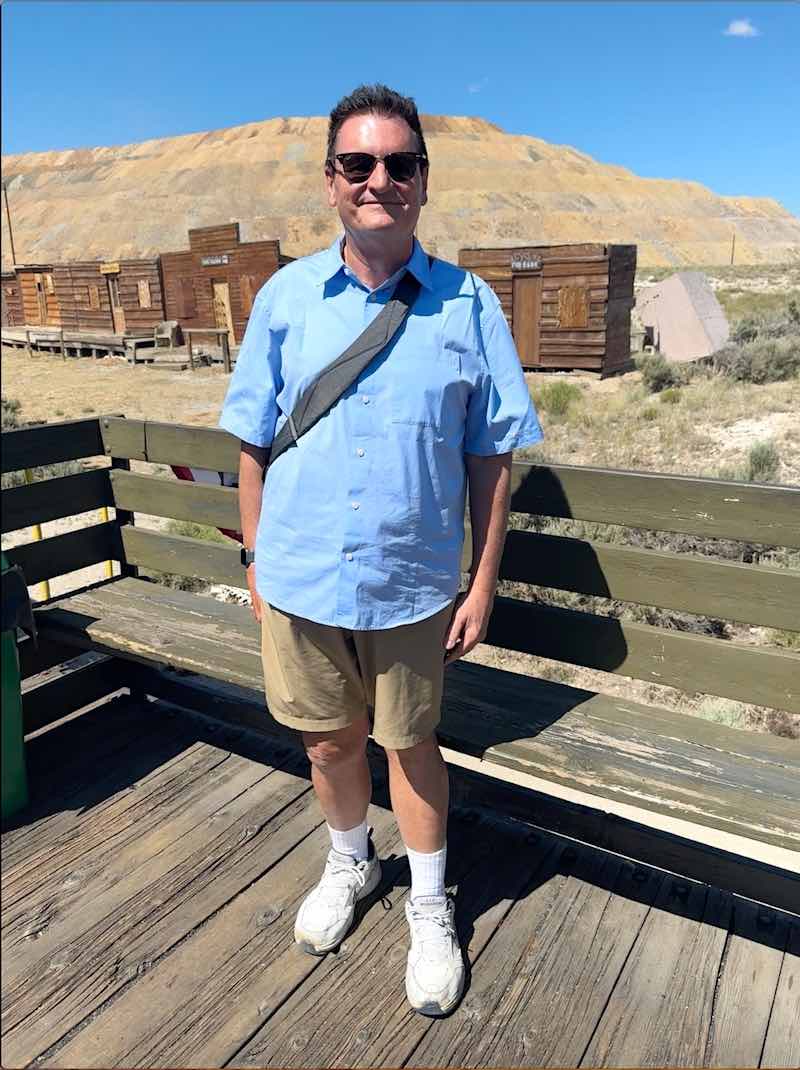
Barry Kramer enjoying the open-air passenger car of the Northern Nevada Railway
The Railroad’s Rebirth
The Virginia and Truckee Railroad was initially established as a commercial freight railroad to transport ore and construction materials between towns along the Comstock Lode in northwestern Nevada. Following its abandonment in the 1950s, the rail line was restored as a privately owned heritage railroad, with a section of the original line reconstructed to run to the small town of Gold Hill. With the assistance of government funding, the train line was further extended to Carson City, the capital of Nevada, in 2009.
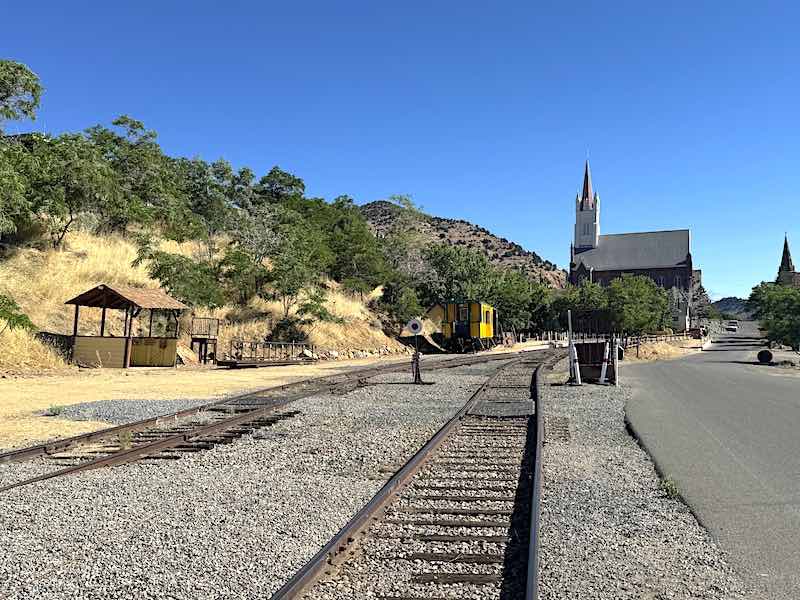
The main railroad depot of the Virginia and Truckee with the famous Mary’s in the Mountains Catholic Church in the background
Today, tourists can take a short line excursion to Gold Hill to learn about the history of the Comstock Lode, while the longer 14-mile excursion offers day trips from Carson City to Virginia City. I had the opportunity to experience the short-line excursion during my stay in Virginia City. The train journey from Virginia City begins at the ticketing office in the original 1857 passenger depot, where the short line operates six daily excursions to Gold Hill.
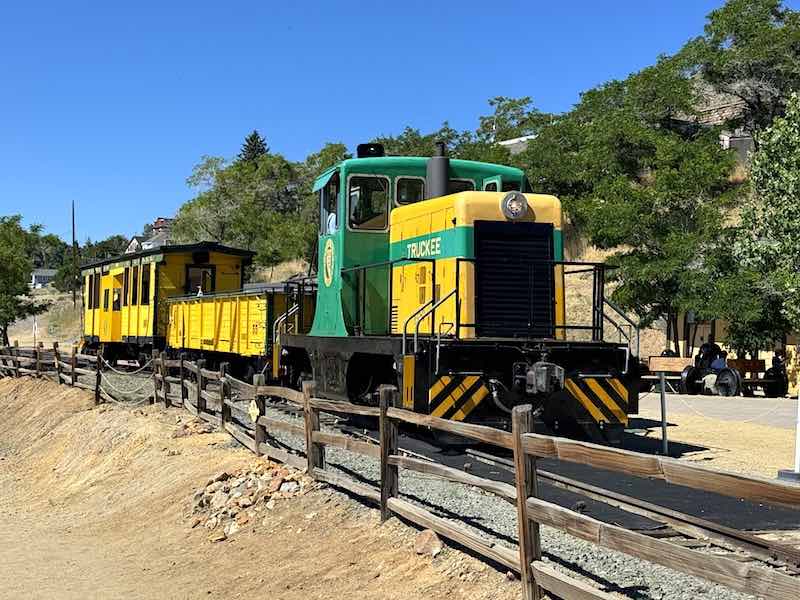
The Virginia and Truckee Short Line train featuring a diesel locomotive
While most trains are powered by a diesel locomotive, a few select weekends during the bustling summer season showcase a steam locomotive. I had initially anticipated a steam excursion when planning my trip to Virginia City, but unfortunately, the railroad line shifted those weekends to later in the summer. The train consisted of one open-air viewing car and one enclosed car. I opted for the enclosed car to avoid the sun.

The rear passenger car of the Virginia and Truckee Short Line train
A Scenic Ride
Most passengers made the same choice, with some seated on the valley view side and others, like myself, on the mountain view side. The valley view side undeniably offered more photographic opportunities, albeit with a little more exposure to the sun. We had a narrator and a second conductor throughout the trip who monitored the tracks for potential rail blockages.
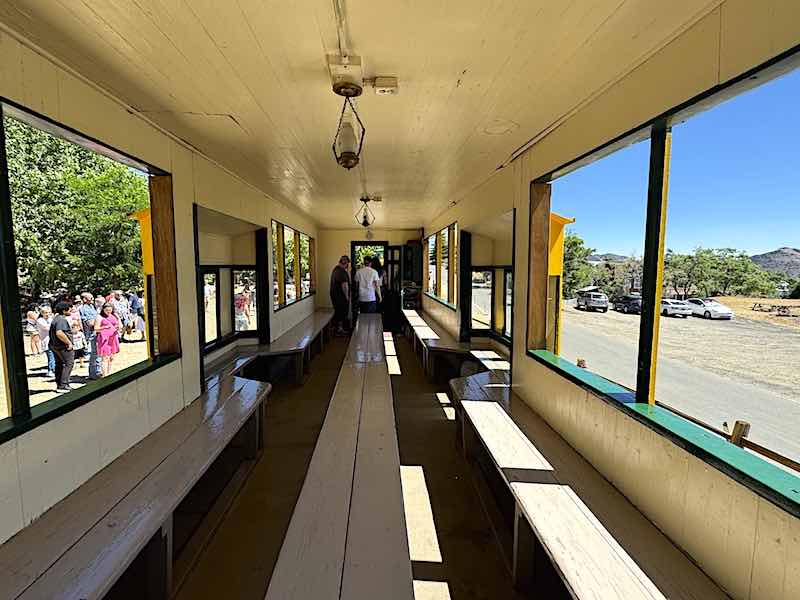
The interior of a passenger car of the Virginia and Truckee Short Line train
Learning About the Comstock Lode
The train conductor provided an informative account of the mining industry and the history of the Comstock Lode, sprinkled with humor. Exploring other attractions in Virginia City, I encountered similar themes and gained valuable knowledge about mining, the railroad, and the history of Virginia City. Initially, I expected a 35-minute journey to Gold Hill on the Virginia and Truckee Railroad, with time to disembark, explore, and return on a subsequent train. However, the trip to Gold Hill turned out to be shorter than anticipated, lasting only about 15 minutes.
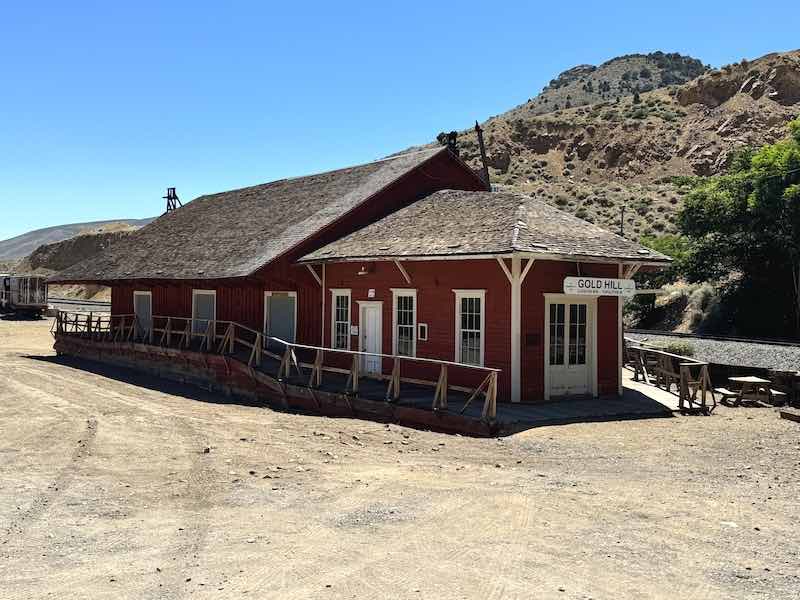
The train depot at Gold Hill for the Virginia and Truckee Short Line train
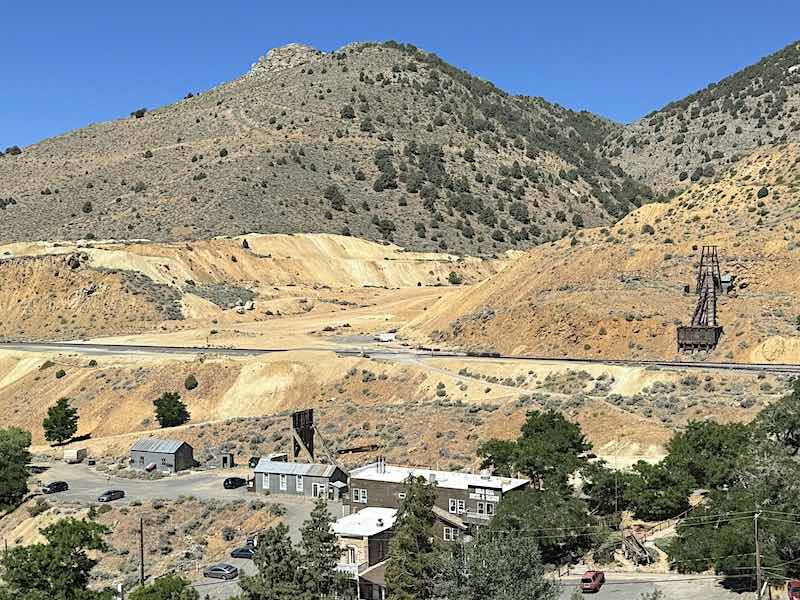
The Yellow Jacket mine in Gold Hill, Nevada
Despite the option to disembark, no passenger chose to do so. The return journey, which was also 15 minutes, retraced the same route back to Virginia City. Later, I visited Gold Hill to explore the Gold Hill Hotel, the oldest establishment in the region. It was wise not to disembark from the train, as there wasn’t much to see in the small town. The entire experience lasted a mere 35 minutes in total, and the relaxed yet bumpy ride was characteristic of a heritage train excursion.
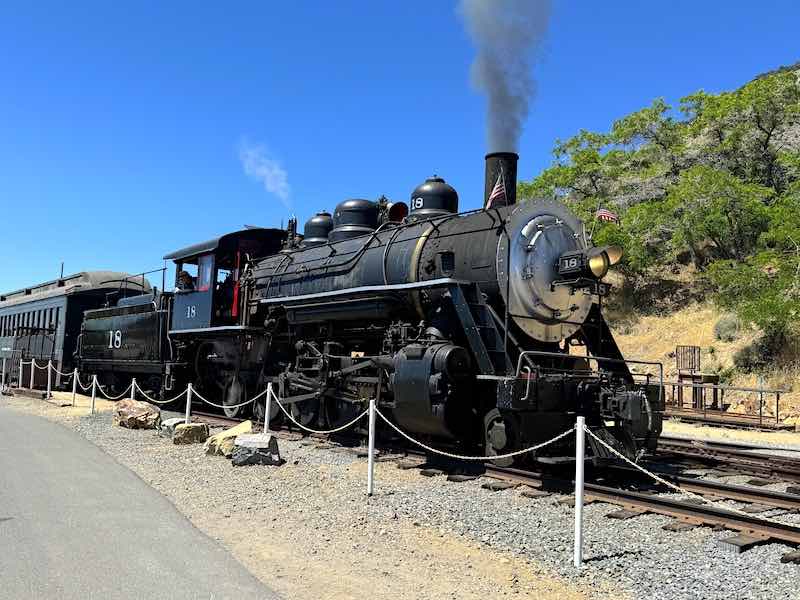
The Virginia and Truckee Steam Locomotive Number 18 arriving at Virginia City from Carson City
A Steam Arrival
Upon our return to the passenger depot, I engaged in a discussion with a conductor and discovered that a steam excursion from Carson City was scheduled to arrive a few minutes after our train. The majestic Baldwin Steam Locomotive Number 18 soon arrived, pulling three passenger cars filled with tourists from Carson City on a day trip. The excitement of the transport attendants waiting for their arrival and the passengers descending from the coach cars felt like a scene out of a Hollywood movie.
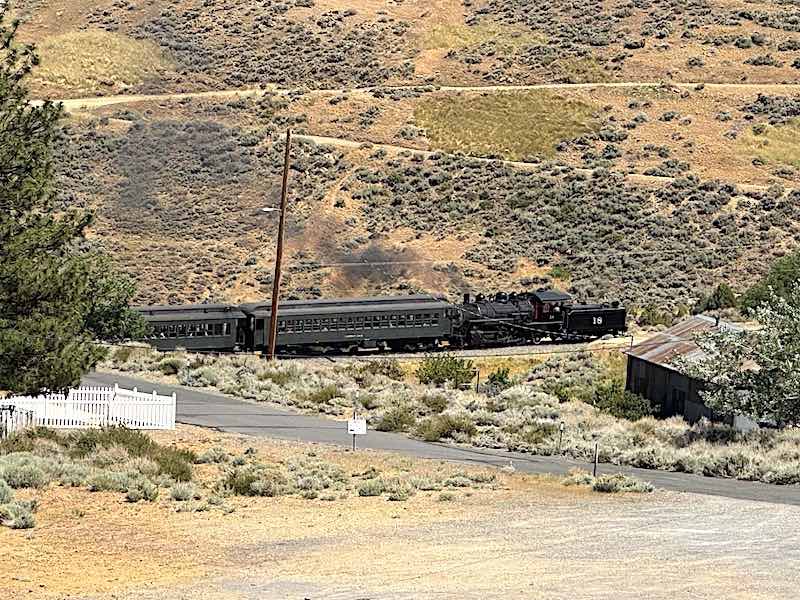
The Virginia and Truckee Steam Steam Locomotive Number 18 returning to Carson City from a day trip to Virginia City
Special Event Excursions
Later in the afternoon, I witnessed the steam locomotive make a grand departure back to Carson City. The Virginia and Truckee also runs special event excursions throughout the year, such as the Electric Halloween Train O’Lights, a Pumpkin Patch train to Gold Hill, a Candy Cane Express, and a popular Heritage Days Battle Train to commemorate the American Civil War complete with reenactments of battles and skirmishes. Overall, the excursion to Gold Hill was enjoyable due to its historical significance.
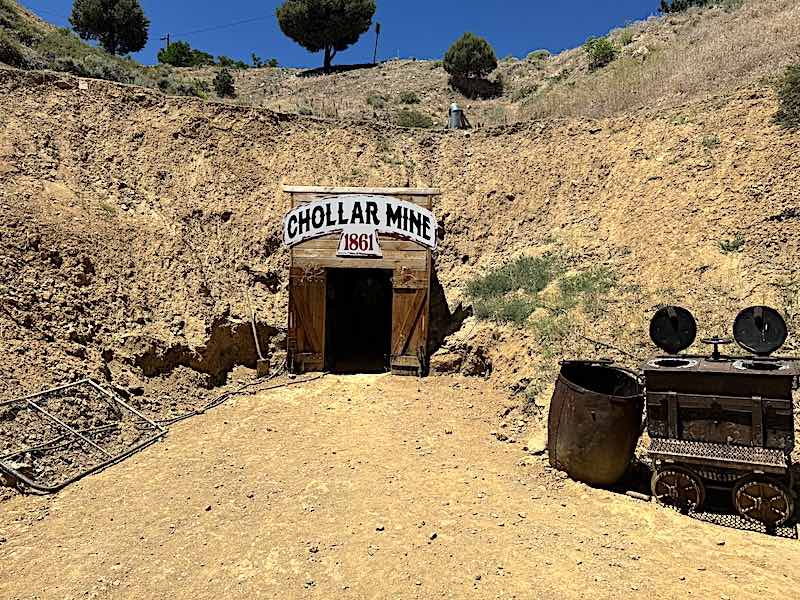
The 1861 entrance to the Chollar Mine in Virginia City, Nevada
Exploring Virginia City
However, the actual experience was a little disappointing, as the ride was short, and a modern diesel locomotive was utilized. I also made time to explore some of the other attractions in Virginia City. Right after my train ride, I went on the Chollar Mine tour, which took me over 400 feet deep into a restored section of the 1861 historic gold and silver mine. Thankfully, the tour required hard hats, as I ended up hitting my head on the ceiling timbers multiple times.
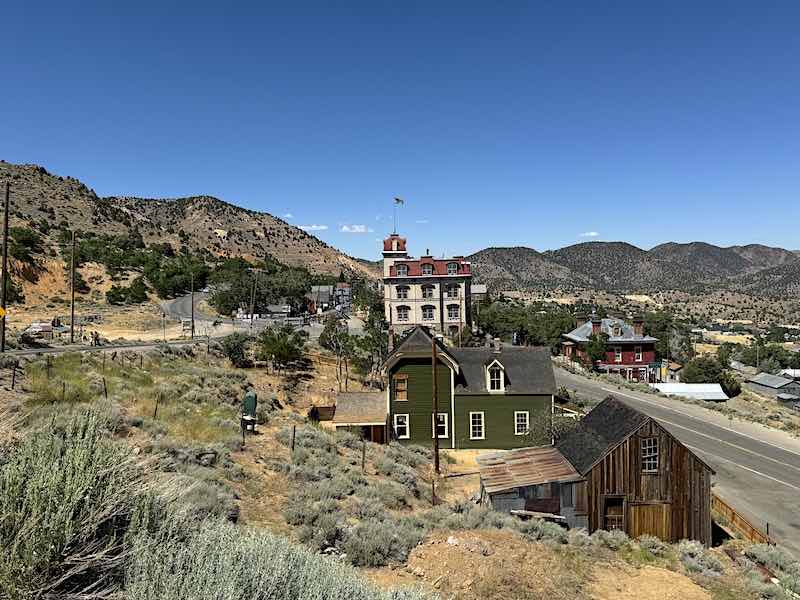
The road into Virginia City, Nevada, with the Historic Fourth Ward School Museum in the center.
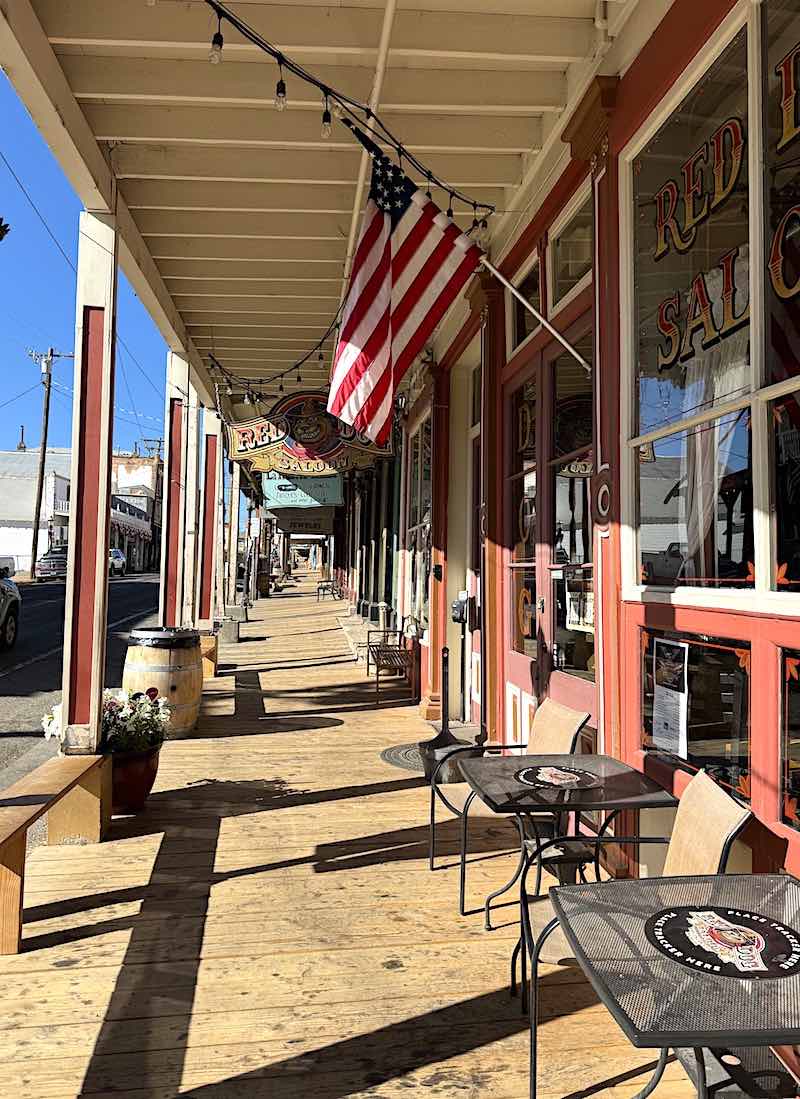
The boardwalk fronting the businesses along the main drag “C Street” in Virginia City, Nevada
After that, I visited the notoriously haunted Piper Opera House, where I had an intriguing docent-led tour and learned about Virginia City’s entertainment history. I then toured the Fourth Ward School Museum to see an 1876 classroom and took a quick trip to explore the sites in the nearby city of Gold Hill. All these experiences were valuable and helped me better understand Virginia City’s boomtown-to-bust history.
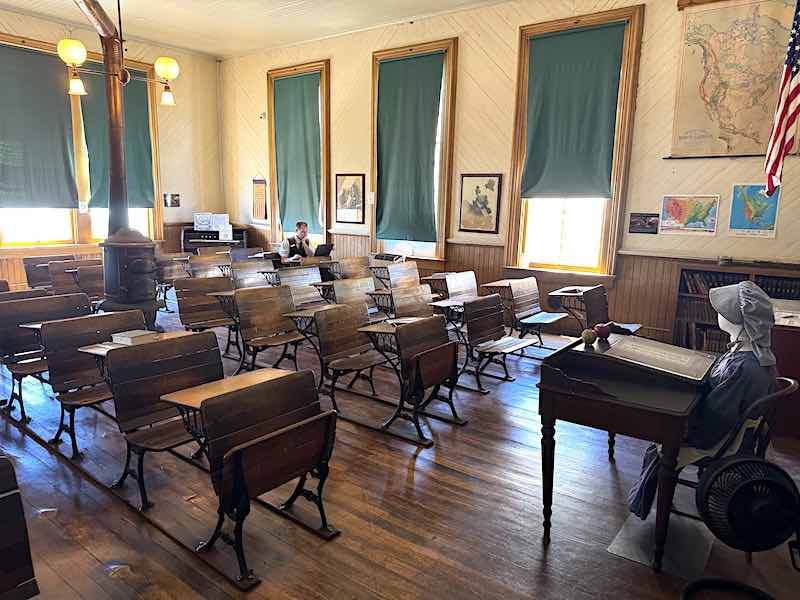
The 1876 classroom in the Historic Fourth Ward School Museum in Virginia City, Nevada
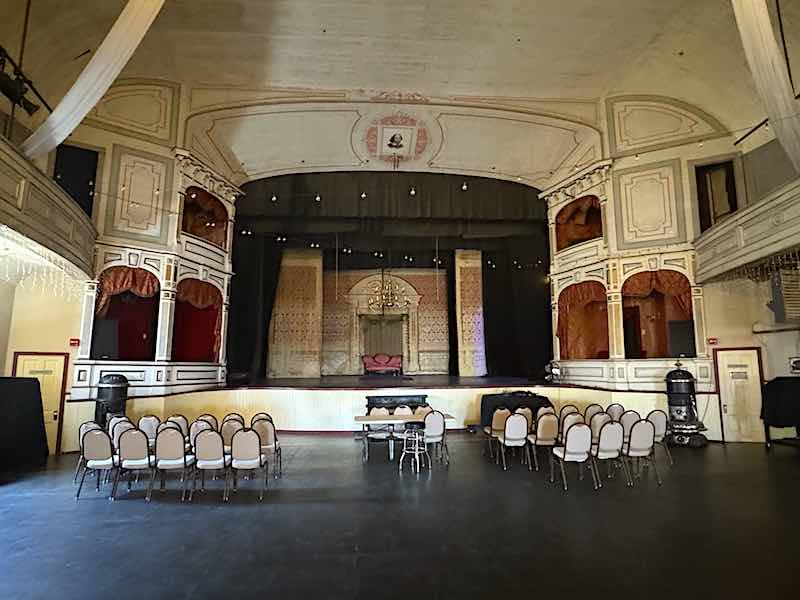
The interior and stage of the Piper Opera House in Virginia City, Nevada
I discovered two remarkable dining establishments in Virginia City. Calamity Jane’s offers delectable breakfast and lunch choices, while The Cafe Rio is renowned for its unforgettable Tex-Mex lunches and dinners. Later in the evening, after most tourists had left, I revisited the historic main street with its boardwalk sidewalks to enjoy dinner at the iconic Red Dog Saloon. Due to the early closing times of many restaurants in Virginia City, it is advisable to plan your meals accordingly.
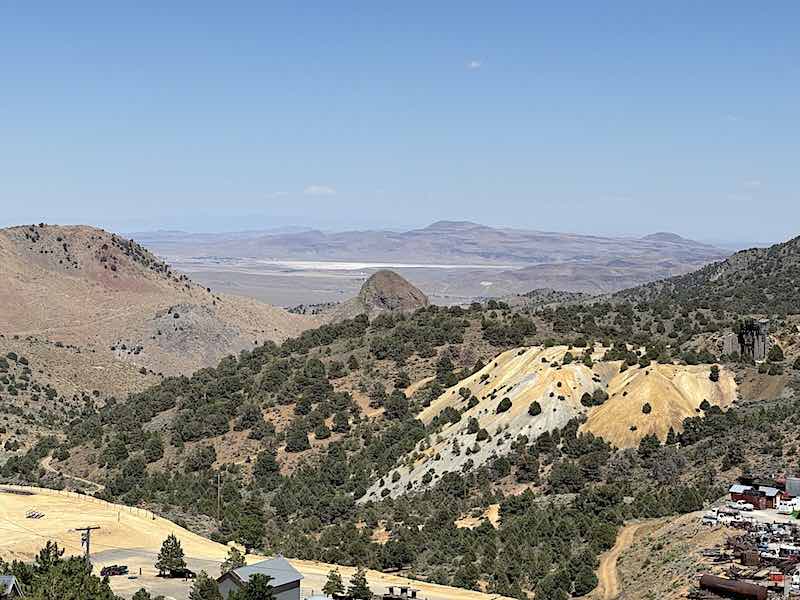
An abandoned Comstock Lode mine with Virginia City’s famous 100-mile view of the Great Basin in the background
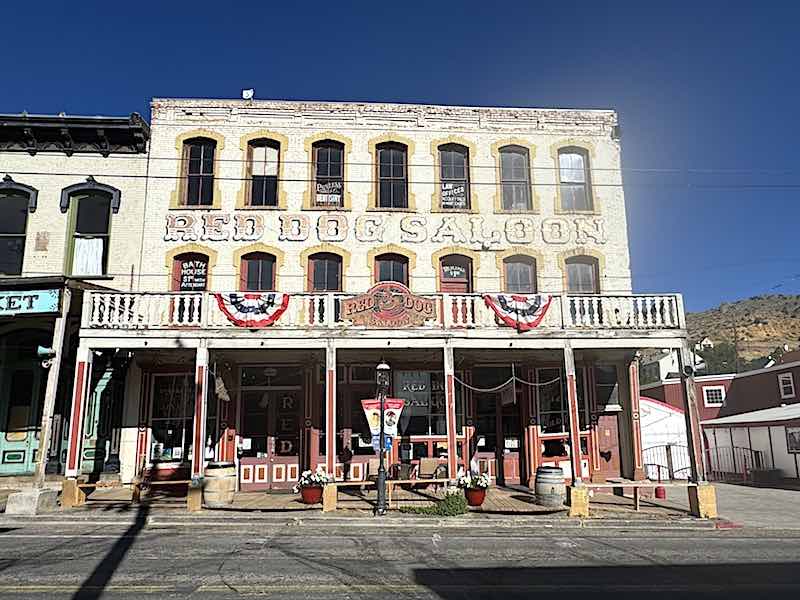
The Red Dog Saloon along the main drag “C Street” in Virginia City, Nevada
All in all, Virginia City was great fun. It serves as an important reminder of Western American history that still thrives as a tourist attraction. Despite its touristy atmosphere, the town still preserves enough historical significance to educate visitors about the Comstock era’s gold rush days and the Old West’s mining history.

“Safety First”, the motto of the Northern Nevada Railway Museum
The Nevada Northern Railway
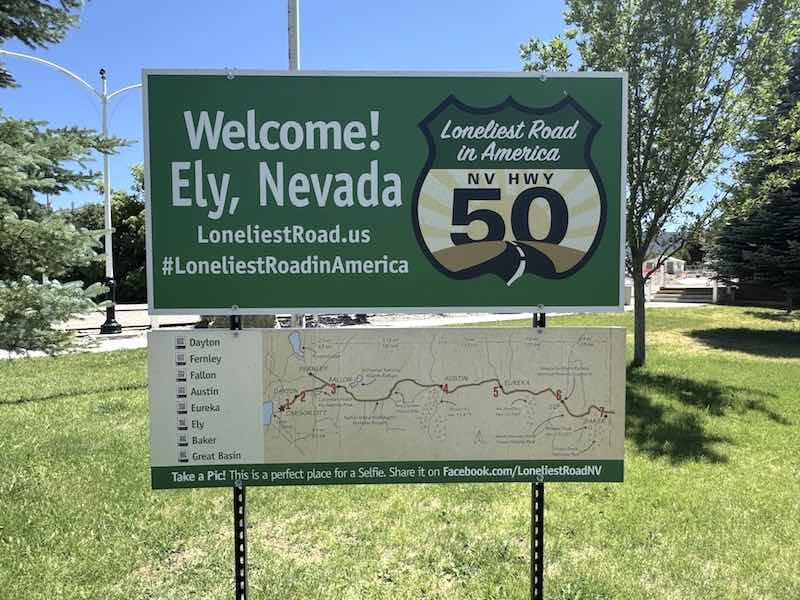
The “Loneliest Road in America” sign welcoming visitors to Ely, Nevada
The Long Road to Ely
The journey from Virginia City to Ely lasted just over 5 hours on Nevada Route 50, which was identified as “The Loneliest Road in America” by Life magazine in 1986. The name was officially adopted by the Nevada Department of Transportation and the Nevada Commission on Tourism, who have installed road signs to encourage travelers to take on the challenge of driving the road. I can attest to the fact that there was very little traffic on the highway, and for most of my journey, I mostly saw open space with a long stretch of road that seemed to go on forever.
The scenery was stunning, especially when I traversed the mountains from valley to valley, but I was grateful that I was well-rested and made this drive after a good night’s sleep. A sign that read “Next Gas 124 miles” brought about a slight sense of unease. In the early 20th century, copper deposits were discovered in the vicinity of Ely, Nevada. This discovery prompted the establishment of extensive ore mining activities, which were brought together under the Nevada Consolidated Copper Company.
The Rise of Copper Mining
In order to efficiently process the ore extracted from the mines, the Steptoe Valley Mining & Smelter Company was constructed in the nearby town of McGill. The selection of McGill as the site for the smelter was based on its convenient access to water sources. The Nevada Northern Railway was established in 1905 to link the Nevada Consolidated mines and smelter to the national railway network to facilitate transportation for the copper mines, workers, and smelting facilities. Eventually, the Nevada Consolidated Copper Company came under the control of the Kennecott Copper Corporation in 1942.
Throughout the years, the towns of Ely and McGill have experienced fluctuations from prosperity to decline due to the rising and falling of copper prices in the global market. By 1983, the Nevada Northern Railway had to halt its operations as a result of the closure of the McGill smelter, diminishing ore reserves, and plummeting copper prices. The infrastructure of the Nevada Northern Railway was left intact because the workers expected it would eventually reopen. Historically, they were accustomed to the repetitive pattern of layoffs and rehiring based on the economic conditions of the copper mining industry.
Preservation and Revival
When the decision was made to permanently cease rail operations in 1986, the Kennecott Copper Corporation generously donated the entire ore line from Ruth to McGill, along with the railway’s yard and shop facilities in East Ely, to the White Pine Historical Railroad Foundation for preservation purposes. Surprisingly, the dramatic surge in copper demand in 2005 has revived Ely as a thriving copper town once again. Presently, the copper concentrate extracted from the mine is transported by truck and rail to port cities in the Northwestern United States, where it is shipped to Asia for smelting.
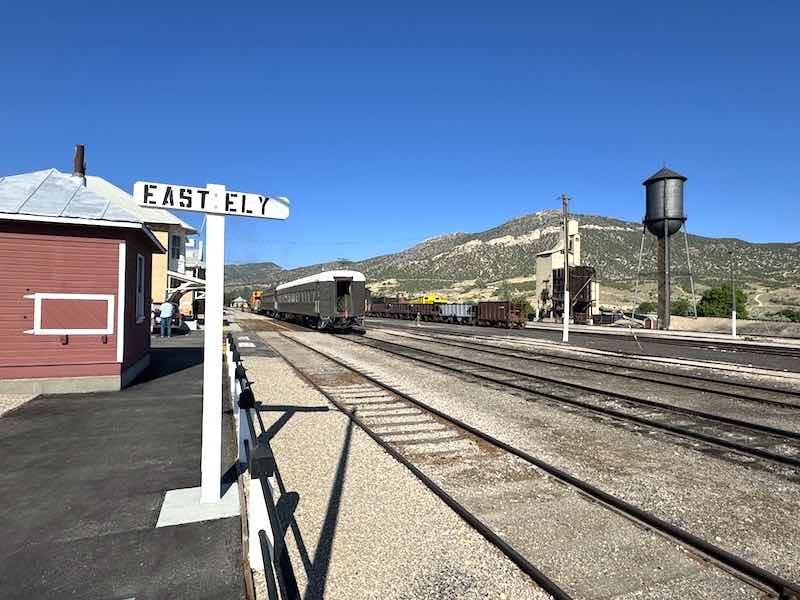
The Northern Nevada Railroad Museum complex in East Ely, Nevada
The Nevada Northern Railroad Museum
The Nevada Northern Railroad Museum, which is both a heritage railroad and museum, is under the ownership of the State of Nevada but continues to be operated by the non-profit White Pine Historical Railroad Foundation. The museum is located at the East Ely Railroad Yard and Shops. Visitors can experience passenger excursion train service between Ely, Ruth, and McGill on trains pulled by historic steam and diesel locomotives. Excursions depart from the East Ely Depot, an authentic Mission Revival-style building completed in 1907.

The 1907 Mission Revival style East Ely Depot
The lower floors now function as a ticketing office and gift shop, while the upper floors house a museum dedicated to the local railway. Visitors can also tour the original machine shop and engine house to witness the maintenance and restoration of the train locomotives. The complex, consisting of over 70 buildings and structures, was designated a National Historic Landmark in 2006. Using the Nevada Northern Railway’s website, I booked an excursion on a date that featured a steam locomotive.
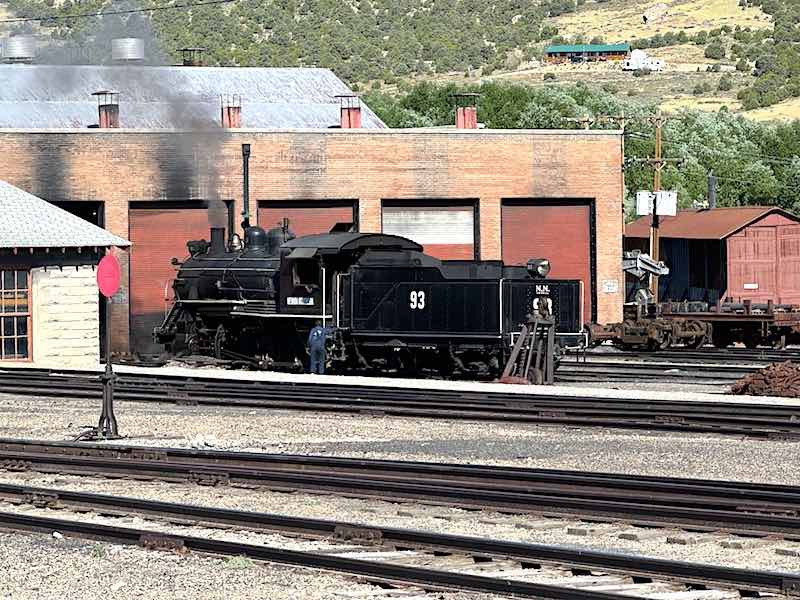
Steam Engine 93 being prepared at the maintenance and machine shop for the day’s journey
A Steam-Powered Excursion
I chose a 9:30 am departure on a pleasant Monday in summer. It was the only scheduled departure available that day, and the entire train only had about 20 passengers on board. I arrived early to capture some photographs and observe the staff preparing Steam Engine 93 for the day’s journey. This particular engine was manufactured by the American Locomotive Company in Pittsburgh in January 1909. Although it was initially retired in 1961, it was restored in 1993 and has since been regularly used for the railway’s excursion rides.
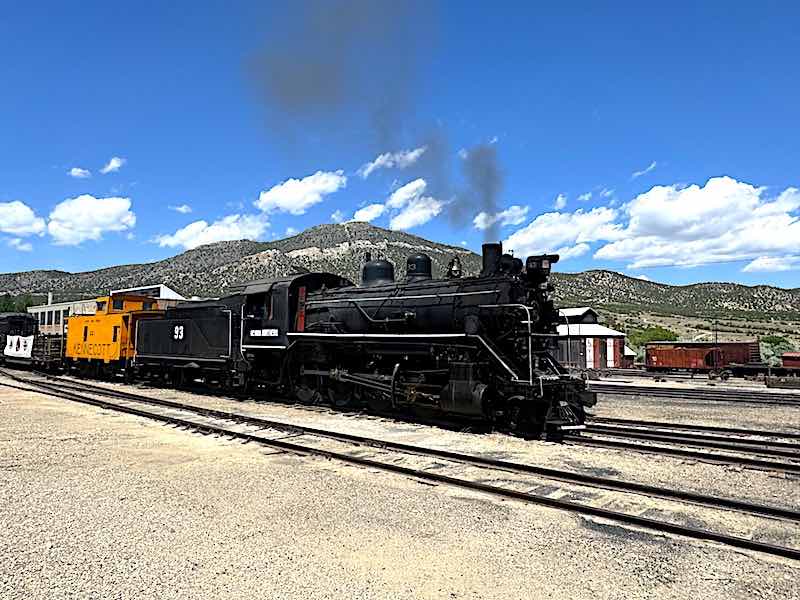
Steam Engine 93 pulling a caboose, open-air passenger car, and passenger coach at the Northern Nevada Railway Museum
Additionally, the railway is refurbishing and restoring two other steam locomotives, including the Baldwin Locomotive Works Engine Number 40, designated as the state steam locomotive of Nevada in 2009. All the steam engines and passenger cars in the Nevada Northern Railway’s fleet proudly display the rail line’s motto of “Safety First.” My journey promptly boarded a few minutes before 9:30 am and departed on schedule. The journey was 90 minutes, and it was a round trip to the Ruth station stop.
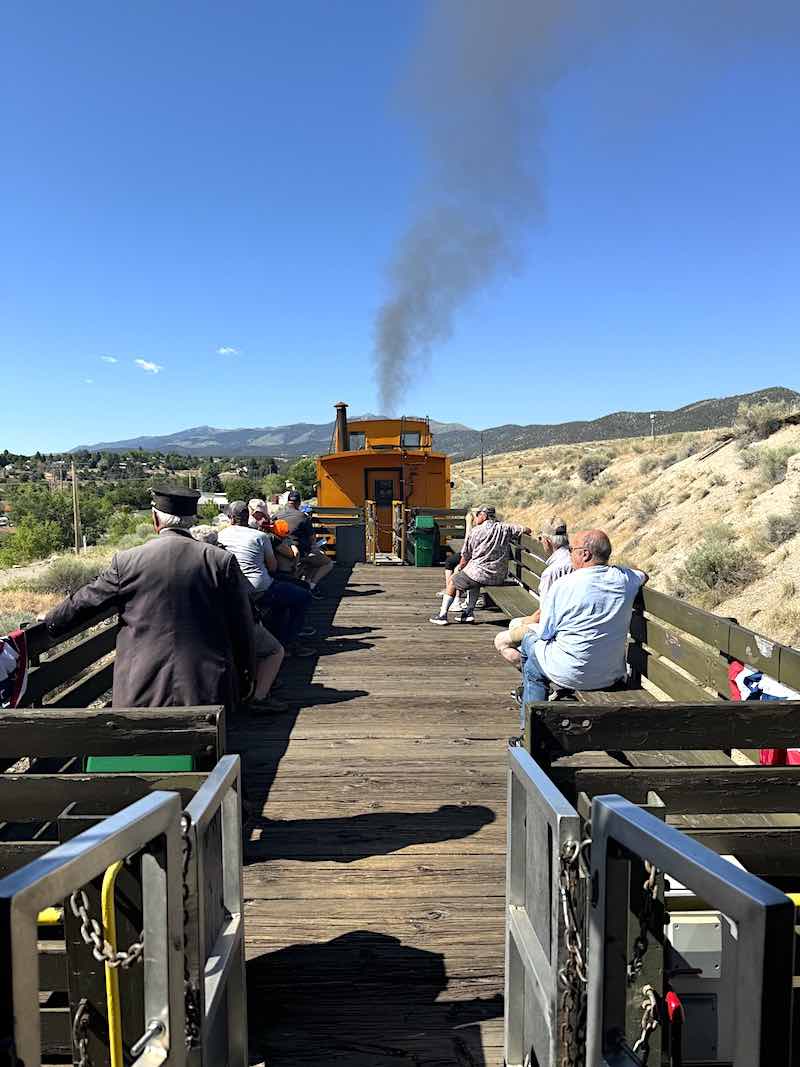
The open-air passenger car looking forward to Steam Engine 93
The Canyon Route
This particular route is commonly referred to as the Canyon Route due to its passage through Robinson Canyon up to the old and current mines along Nevada State Route 50. Two restored passenger cars, an open-air car and a caboose, were available behind the locomotive. The steam excursions on the Nevada Northern Railway are authentic coal-fired steam trips that offer visitors a glimpse into what an operational railroad was like in the early 1900s. Opting to sit outside in the open-air car, I had a clear view of the steam engine ahead of me.
The experience was exhilarating as the train carefully departed from the railroad yard and switched tracks for the journey. A conductor punched my ticket, providing informative narration throughout the route. As the train gained speed and passed through downtown Ely, smoke billowed from the engine’s smokestacks. Onlookers in the city paused to watch and wave as we passed by. The smoke and steam emitted by the engine resulted in clouds of coal dust settling on us, along with mists of water vapor.
Later in the day, it took several washings to remove all the coal dust from my hair. When we traversed the two tunnels along the route, the conductor advised those standing outside to face away from the engine. This guidance proved valuable, as we could feel a strong blast of heat and coal dust descend on us in the confines of the tunnel. Undoubtedly, this was one of the most exciting steam engine rides I had ever experienced.
Exploring Ruth and Ely
We encountered abandoned gold, silver, and copper mines and deserted old cities during our journey. Ruth may have once been a regular stop on the ore line, but it now functions as a turnaround point for the train. Following a backup switching maneuver, the train was prepared to head back to East Ely. Even though the ride was 90 minutes long, it seemed to pass swiftly, and we were back through the tunnels into the town of Ely. To our surprise, the entire train backed up to the maintenance and machine shop first, allowing passengers to disembark and explore the facility.
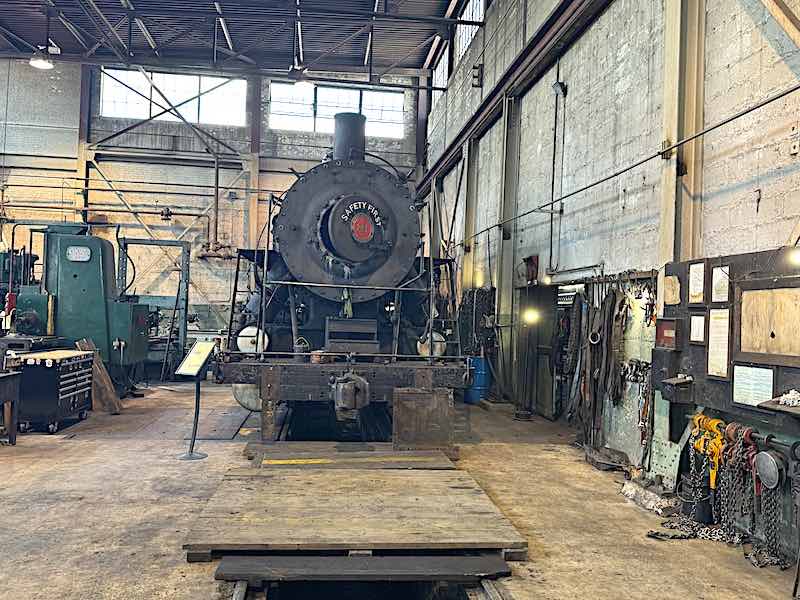
Steam Engine 81 being refurbished in the Northern Nevada Railway Museum’s maintenance and machine shop
Touring the Maintenance Facility
I was truly impressed, as gaining access to an authentic steam restoration facility is quite rare due to safety concerns. Most passengers disembarked and received a comprehensive tour of the facilities, where we witnessed two steam locomotives undergoing restoration, along with two coaches. We also observed where all the working engines were stored and serviced and the equipment used for railroad maintenance. One of the workers was present and willingly answered all our inquiries regarding the efforts involved in maintaining the historic trains.
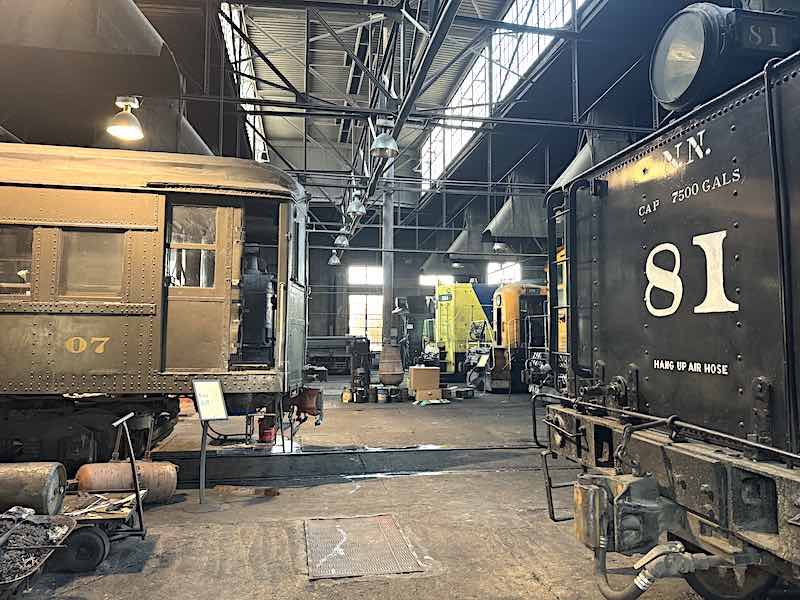
A passenger coach and steam engine being restored in the Northern Nevada Railway Museum’s machine shop and engine house
One of the highlights of the journey was listening to anecdotes about the railroad’s shop cat, “Dirt,” who has become the official mascot of the railroad. Dirt earned his name due to his tendency to get covered in coal dust. Unfortunately, he passed away in 2023, and his final resting place can be found near the ticketing offices. Dirt Junior’s successor now oversees the shop and carries on the legacy. My visit to the ticketing depot, maintenance facility, machine shop, engine house, and steam excursion was one of the most authentic steam engine excursion sites I have experienced.
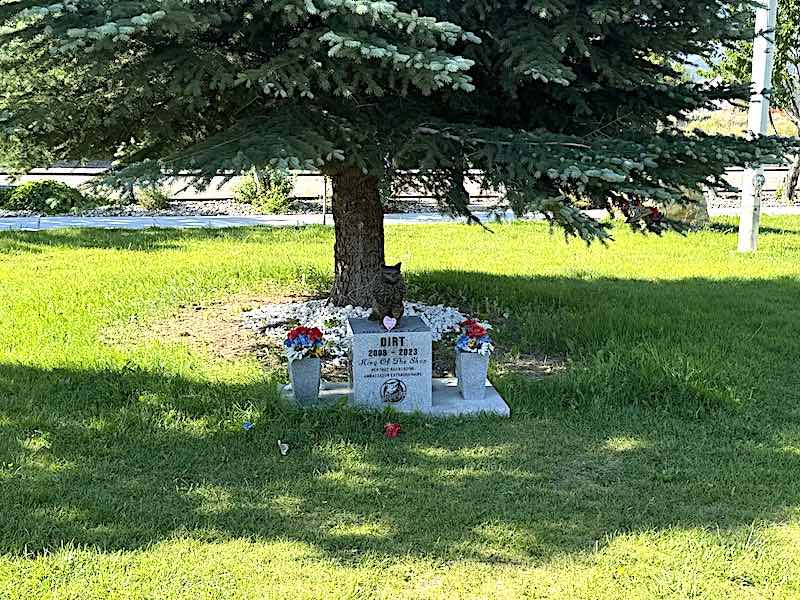
The burial place of “Dirt,” the shop cat, who has become the official mascot of the Northern Nevada Railway Museum
The dedication of the staff, volunteers, and trustees was evident throughout the journey, as they worked tirelessly to maintain the ambiance of a train journey from the early 1900s. The impressive collection of original equipment and the well-preserved setting took me by surprise. The Northern Nevada Railway’s operation stands out as one of the most complete and genuine heritage rail operations in the United States. I inquired about how they managed to preserve everything from the original operation, and our tour guide explained that the location’s isolation played a key role, as materials were left behind and abandoned when operations ceased.
The Impact of Isolation
Due to Ely’s remoteness, it was difficult and costly to transport and sell off scrap metal. Additionally, the prompt response of the community to preserve the facility allowed for a seamless transition into a museum. As I departed from the rail depot, I knew that I had seen a truly unique part of American history. The Northern Nevada Railway provides a variety of themed excursions, including the Haunted Ghost Train, Santa’s Reindeer Flyer, Fire and Ice Fireworks, Pumpkin Patch, Wild West, and Roaring 20s excursions.
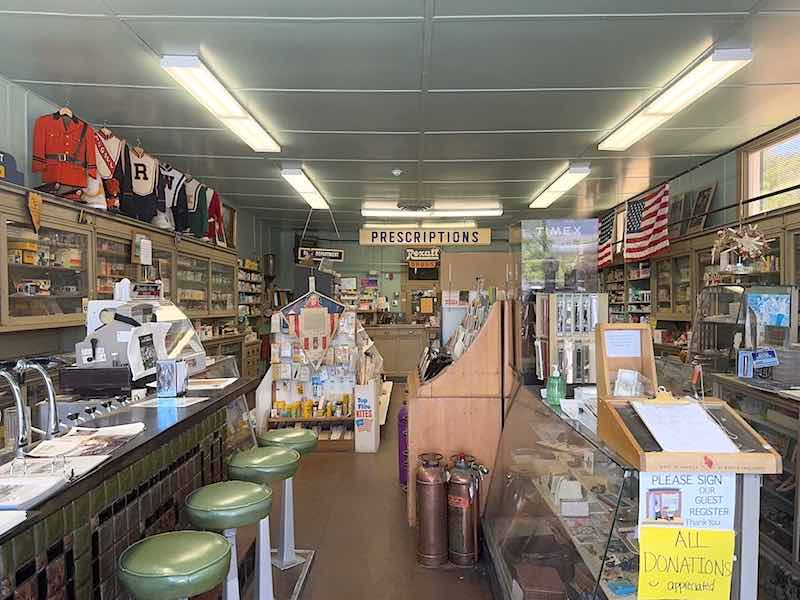
The McGill Drugstore Museum in the neighboring city of McGill, Nevada
Stargazing and More
Among these, the summer Star Train excursions are particularly popular. They offer passengers the opportunity to stargaze with the assistance of the Dark Rangers of Great Basin National Park as the train passes through dark sky areas outside of Ely. The excursions are in such high demand that they often sell out a year in advance. During my time in Ely, I had the opportunity to make two additional visits. The first stop was at the McGill Drugstore Museum in the neighboring city of McGill.
Stepping Back in Time
This museum is a former drug store that operated from 1915 to 1979. The original store closed when the nearby Kennecott Copper mine shut down. Today, visitors can experience the drugstore exactly as it was in 1979, with its entire inventory intact, including prescription medication. It was truly a step back in time. Additionally, I took a one-hour drive from Ely to visit the Great Basin National Park in eastern Nevada, near the Utah border.
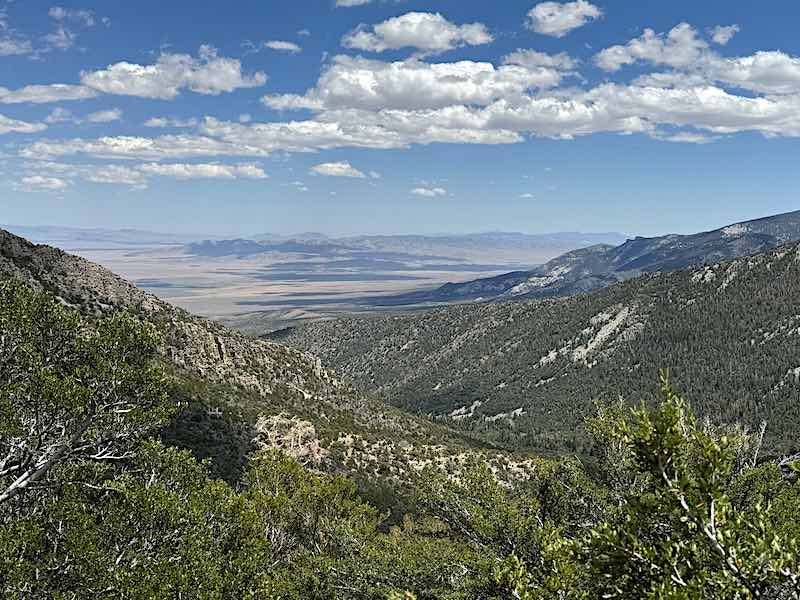
A view of the Great Basin from Great Basin National Park in Nevada
Exploring Great Basin National Park
I drove up to 10,000 feet above sea level along the Wheeler Peak Scenic Drive to enjoy picturesque views of the nearly 14,000-foot Wheeler Peak. The viewpoints also provided opportunities to see bristlecone pine trees and the vast vistas of the valleys of the Great Basin below. I also explored a section of the park’s Lehman Caves to see its unique stalactite and stalagmite formations. The Great Basin National Park offers numerous opportunities for hiking and camping, along with a wide range of nature programs sponsored by rangers and volunteers.

The Wheeler Peak Scenic Drive in Great Basin National Park
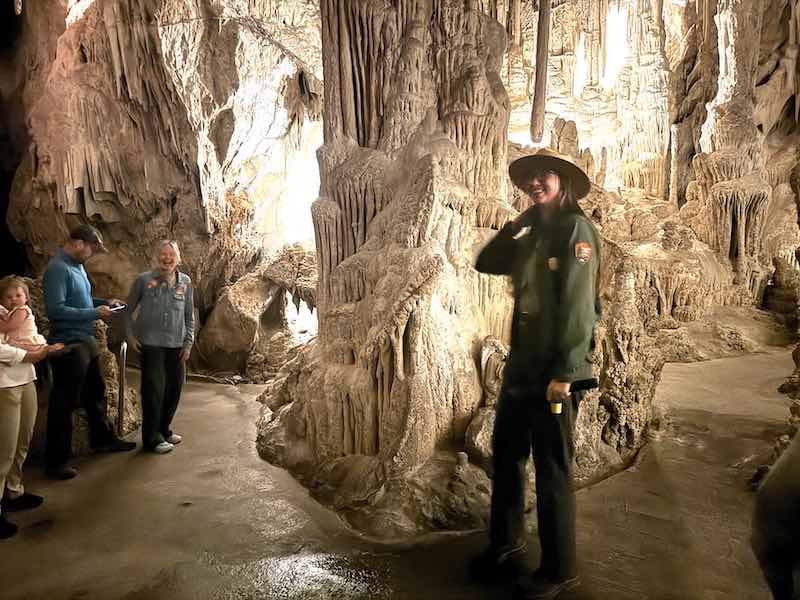
A guided tour of Lehman Caves in Great Basin National Park
The park has been recognized as one of the premier International Dark Sky Parks in the United States for its clear night skies unimpeded by light pollution. Additionally, the park hosts a popular Astronomy Festival, and during the summer, the Great Basin Astronomy Rangers offer multiple programs each week.
Conclusion
I spent four days traveling north along Nevada Route 95 from Las Vegas, then east along Route 50, and finally south back to Las Vegas to visit two renowned railroads of northern Nevada. I was truly impressed by both rail lines, each holding a unique place in the history of the western United States by supporting the gold, silver, and copper mining industries. Reflecting on my experience riding these rail lines, I realized I had gained a few important travel insights.
In hindsight, I believe it would have been more enjoyable to take a day trip from Carson City and spend the day exploring Virginia City. Virginia City has a plethora of attractions, but most of them can be experienced on a day trip, and a steam excursion would be a better experience than the small, short-line ride. Although the Nevada Northern Railroad offered an incredibly authentic experience, the journey to Ely was quite lengthy. The additional drive to the Great Basin National Park definitely made driving to this isolated area of eastern Nevada worth it.
Planning for Success
It is important to note that planning and booking in advance during the summer months is essential to ensure the best experience and secure desired tour times for both locations. I started my journey into northern Nevada to ride two old-time historic trains, but what I experienced was so much more. As I visited towns with deep roots in the American mining industry, I witnessed the rise and fall of boomtowns. I further encountered individuals dedicated to preserving the region’s history and educating others about its significance in shaping the United States.
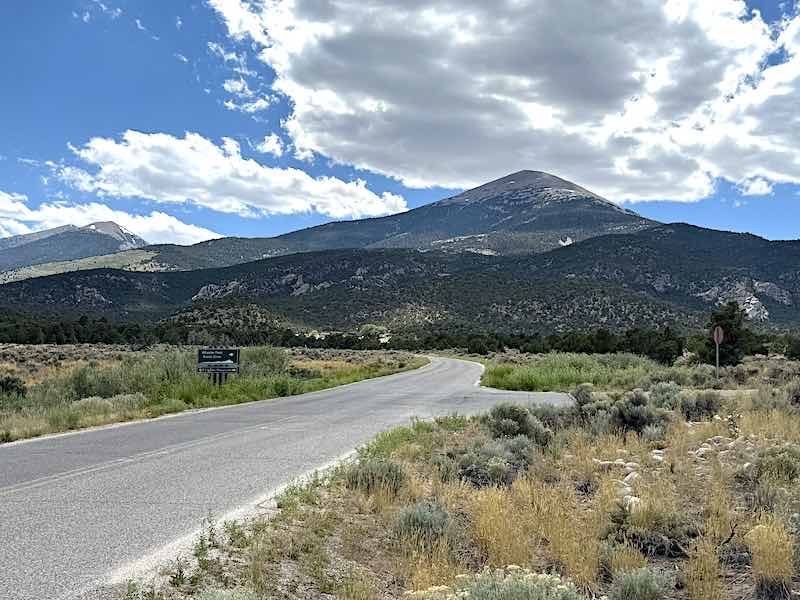
Scenic roads in the Great Basin region of Nevada
Awe-Inspiring Landscapes
Most notably, the stunning landscapes of the Great Basin left me in awe with every mile I traveled. The railroads of northern Nevada are much more than just old trains. They serve as a reminder of an era that played a crucial role in the nation’s development, and they are a symbol of the resilient individuals who braved a harsh environment to provide the minerals and metals we still depend on in our modern age.
Leave a Reply
Tags: article, nevada, train travel

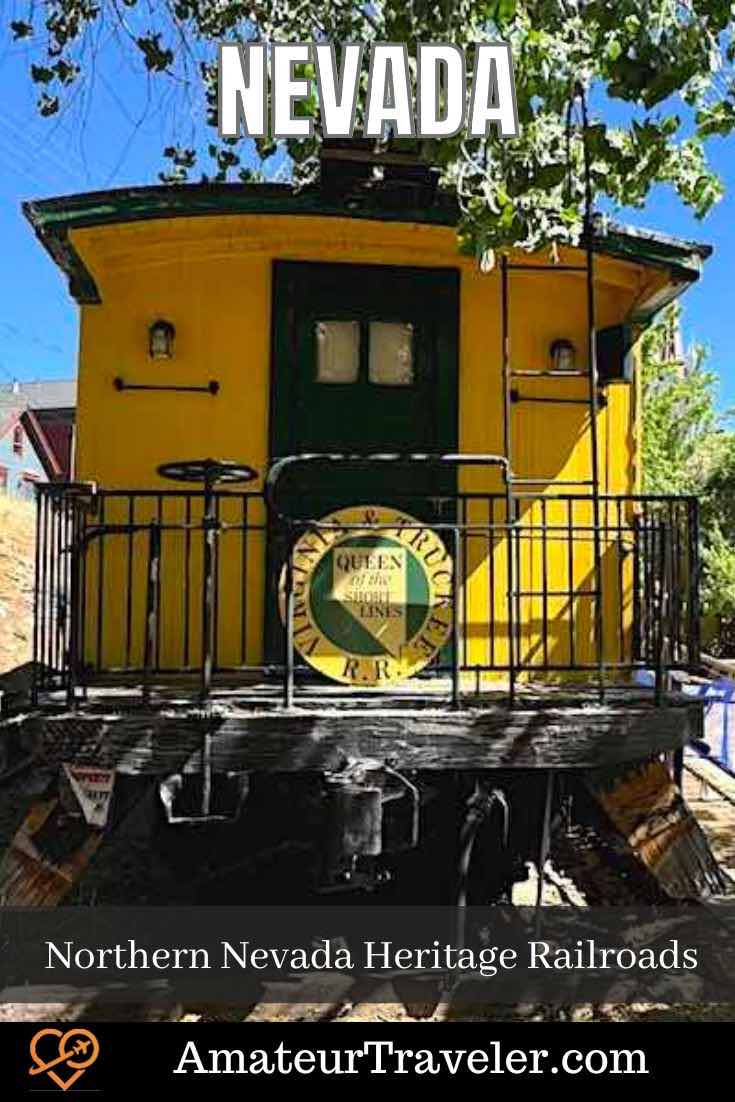
 21 Best Things to Do in the Sierra Nevada Mountains
21 Best Things to Do in the Sierra Nevada Mountains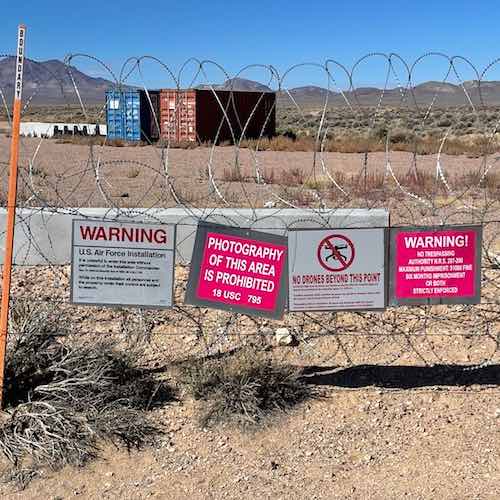 Las Vegas to Area 51 – Searching For Extraterrestrials In The Nevada Desert
Las Vegas to Area 51 – Searching For Extraterrestrials In The Nevada Desert Best Motorcycle Road Trips in Nevada
Best Motorcycle Road Trips in Nevada Las Vegas, Nevada – Episode 47
Las Vegas, Nevada – Episode 47
